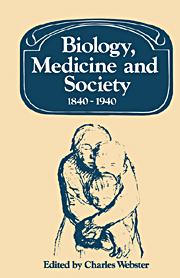Book contents
- Frontmatter
- Contents
- Contributors
- Preface and Acknowledgements
- Introduction
- 1 Women's Health and the Women's Movement in Britain: 1840–1940
- 2 Working-Class Mothers and Infant Mortality in England, 1895–1914
- 3 Theories of the Cell State in Imperial Germany
- 4 Innate Character in Animals and Man: A Perspective on the Origins of Ethology
- 5 Genetics in the United States and Great Britain 1890–1930: A Review with Speculations
- 6 Eugenics and Class
- 7 Sociobiologies in Competition: The Biometrician–Mendelian Debate
- 8 Psychologists and Class
- 9 Measuring Intelligence: English Local Education Authorities and Mental Testing 1919–1939
- Index
1 - Women's Health and the Women's Movement in Britain: 1840–1940
Published online by Cambridge University Press: 02 December 2009
- Frontmatter
- Contents
- Contributors
- Preface and Acknowledgements
- Introduction
- 1 Women's Health and the Women's Movement in Britain: 1840–1940
- 2 Working-Class Mothers and Infant Mortality in England, 1895–1914
- 3 Theories of the Cell State in Imperial Germany
- 4 Innate Character in Animals and Man: A Perspective on the Origins of Ethology
- 5 Genetics in the United States and Great Britain 1890–1930: A Review with Speculations
- 6 Eugenics and Class
- 7 Sociobiologies in Competition: The Biometrician–Mendelian Debate
- 8 Psychologists and Class
- 9 Measuring Intelligence: English Local Education Authorities and Mental Testing 1919–1939
- Index
Summary
The statistics for improvements in women's health since the 1840s are impressive. Between 1840–9 and 1960–5 the death-rate of women between the ages of twenty-five and thirty-four in England and Wales fell continuously from 10.6 to 1.8 per thousand. The ratio of male to female mortality in England and Wales (adjusted for age differences) was simultaneously rising – from 1.096 in 1841– 5 to 1.276 in 1931–5. Maternal deaths per thousand live births in the United Kingdom fell from 4.71 in 1900–2 to 0.17 in 1972–4. These trends continue: for example, perinatal mortality per thousand births in Great Britain fell from 37.7 in 1949 to 34.6 in 1959, to 23.6 in 1969, to 19.5 in 1975. Female deaths due to pregnancy, childbirth or abortion fell strikingly between 1968 and 1975. There are no comparable statistics for levels of morbidity, whose relationship to levels of mortality is complex; but the improvement in mortality rates is impressive enough in itself, and the continuous fall in the age of menarche – by three to four months per decade during the last century – reflects an improved nutrition which can hardly have left morbidity levels unaffected.
Many factors apart from improved nutrition have combined to produce this improvement: improved standards of public health, a reduced birth-rate which has the advantage of concentrating births at physiologically the most suitable time, and the dramatic decline in puerperal sepsis. The period has also seen major improvements in the diagnosis of pregnancy, in the understanding of
I am most grateful to Mrs Jenifer Hart, of St Anne's College, Oxford, for commenting on an earlier draft of this essay; I alone am to blame for any mistakes which remain.
- Type
- Chapter
- Information
- Biology, Medicine and Society 1840–1940 , pp. 15 - 72Publisher: Cambridge University PressPrint publication year: 1981
- 4
- Cited by

